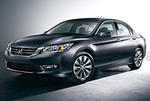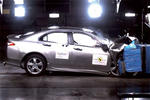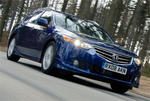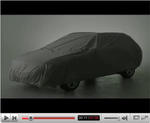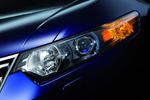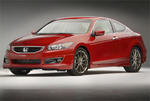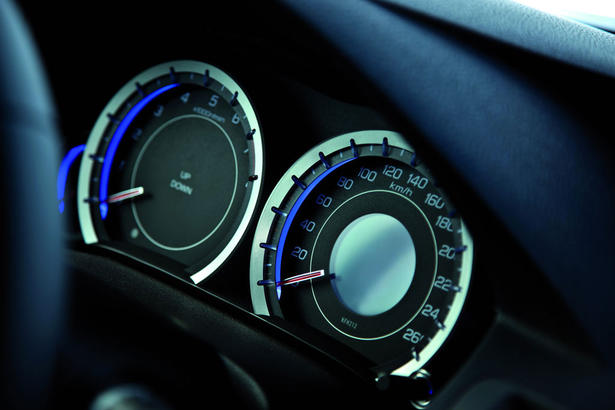
Honda UK has released the first photos and details of the European version of the 2009 Honda Accord, both Tourer and Sedan. The Euro 2009 Honda Accord will be launched at the Geneva Auto Show in March along with a more detailed technical description.
The 2009 Honda Accord will feature a new i-DTEC second-generation diesel developing 350 Nm (258lb.ft) at 2,000 rpm. The 2.0-litre petrol i-VTEC engine outputs 156 PS at 6,300 rpm and will have improved fuel economy.
Honda Press Release:
Honda's all-new Accord will provide a strong challenge to the traditional premium manufacturers in the D-sector, with sporty
styling, greater refinement and excellent driving dynamics. All engines in the line up will be Euro 5 emissions compliant, and the model will feature a sector-leading package of safety systems.
The new Accord's styling is an evolution of the current model, although it's significantly wider and slightly lower than its predecessor, and adopts a 'sharp-edged' design with muscular wheel arches to emphasise the car's wider track.
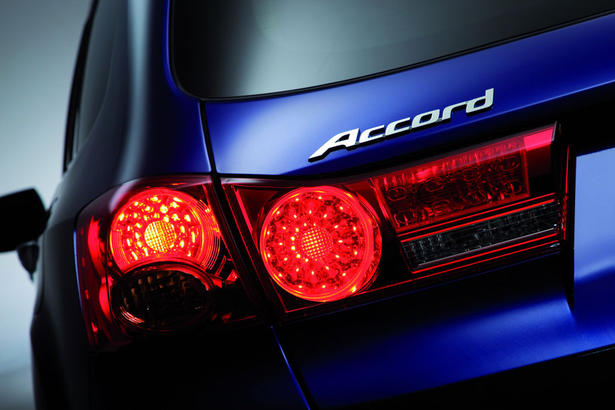
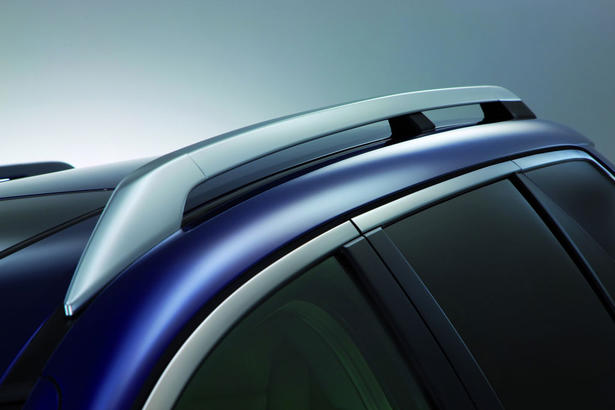
The more sporty approach to exterior design is perhaps best expressed in the new Tourer, which still offers incredible versatility and practicality, but a mix of curves and crisp lines at the rear give the estate a more stylish overall appearance.
THREE ADVANCED, LOW EMISSION ENGINES
Making its debut in Accord is Honda's second-generation diesel engine - the i-DTEC - which builds on the outstanding qualities of the award-winning i-CTDi unit. Not only is the new diesel more powerful - offering 150PS at 4,000rpm -
it also offers cleaner emissions and is smoother to drive.
Like its predecessor, the new i-DTEC engine is compact, lightweight, refined and quiet in operation. It employs the latest piezoelectric multi-stage fuel injection technology, more efficient exhaust gas recirculation and a particulate filter for significantly reduced emissions. Peak torque is now 350 Nm (258lb.ft) at 2,000 rpm.
The 2.0-litre petrol i-VTEC offers 156 PS at 6,300 rpm, and improves on its class-leading fuel economy. Key technological changes include increased diameter intake valves, further optimised valve lift and timing and increased inlet and exhaust air flow volumes.
Meanwhile, the 2.4-litre i-VTEC engine is more powerful, delivering a respectable 200PS at 7,000 rpm and peak torque of 233 Nm (187 lb.ft) at 4,500 rpm. Behind the figures are a compression ratio increased from 10.5 to 11.0:1, larger valves, revised valve timing, and reduced exhaust system pressures.
All three engines are matched to a 6-speed manual transmission, while both petrol engines have the
option of a 5-speed automatic. An automatic gearbox for the i-DTEC engine will be launched in early 2009.
Manual models feature a Shift Indicator Light which appears in the centre of the rev counter. 'UP' or 'DOWN' graphics are displayed to advise the driver of the optimum point (in terms of best fuel economy) at which to change gear; Honda tests have demonstrated fuel savings of as much as five per cent by following these commands.
AGILE, SECURE HANDLING
To create a more involving, communicative drive, the Accord development team used the highly-rated BMW 3 Series as a benchmark, and enthusiastic drivers will appreciate the new car's greater agility. A lowered centre of gravity, a wider track and the all-new front double wishbone and rear multilink suspension with variable rate dampers, plus greater body rigidity mean that the Accord more readily reacts to driver input. Handling is more responsive and confidence-inspiring and body roll has been reduced.
Speed sensitive electric power steering is standard on all models and the new axial system features a high output, low inertia brushless motor which provides excellent steering feel at higher speeds for a sense of stability and confidence. A quicker steering ratio has also been adopted in keeping with the Accord's more agile chassis characteristics.
PREMIEM INTERIOR WITH OUTSTANDING FIT AND FINISH
Inside the Accord, the car's dynamic characteristics are reflected in the driver-focused cabin, with a dashboard that extends from the centre console to sweep around the front seats, creating a cockpit-like design. The width of the car has allowed this without intruding on driver or passenger space, thus maximising comfort levels.
The dash itself features 'floating' backlit instruments, with an LCD multi-information display contained within the centre of the speedometer face. Controls positioned on the steering wheel allow the driver to cycle the display through multiple screens of information. A new feature is a service reminder that presents the driver with either the distance or days remaining to a required service, with an enlarged warning symbol appearing when the due date is imminent.
Meanwhile, stylish and highly supportive front seats have larger bolsters while a new internal structure is designed to reduce any transmission of vibration.
The three spoke steering wheel follows a similar design to recent Honda models, and holds a complete suite of controls - including audio, cruise control and mobile telephone control. It is fully adjustable for reach and rake, with an extra 10 degrees of tilt adjustment compared to the previous Accord.
Clever storage solutions ensure the car is as practical as ever, including two centre console side pockets; a lidded storage area to side of the steering wheel; large front door pockets able to hold bottles and maps; bottle holders in the rear door panels, and a large centre console box.
COMPREHENSIVE SAFETY PACKAGE
As well as a host of passive safety features, the new Accord boasts an outstanding array of dynamic systems delivering even greater security. Vehicle Stability Assist (VSA) is standard across the range and is designed to assist the driver in maintaining control during cornering, acceleration and sudden manoeuvres by applying braking to the right or left hand wheels as necessary and modulating the engine torque output as required.
The new Accord also features an innovative system that utilises both VSA and the car's Electric Power Steering. Called Motion Adaptive EPS, it detects instability in slippery conditions both during cornering and under braking and automatically initiates steering inputs aimed to prompt the driver to steer in the correct direction.
The input is barely noticeable and control of the steering remains with the driver at all times. But this supporting steering torque is enough to prompt the driver to act intuitively and the driver's reaction as a result is enough to regain stability or to shorten braking distances, allowing control to be maintained.
Another important feature of Honda's VSA is Trailer Stability Assist which ensures, by using a combination of reduced engine torque and selective braking, that the vehicle is slowed to a safe and stable speed if snaking should occur while towing.
Honda continues to bring its latest safety technology to more drivers by offering an updated version of ADAS (Advanced Driving Assist System) as an option - and for the first time this will feature CMBS (Collision Mitigation Braking System).
CMBS monitors the distance and closing rate between the Accord and the car directly in front of it, warning the driver of a likely collision with alarms and seatbelt 'tugs'. If the system detects that a collision is unavoidable, it automatically applies braking to reduce the effects of an impact.
ADAS also includes Lane Keeping Assist System (LKAS) which uses a camera to detect the car deviating from a traffic lane and provides steering torque when necessary, thereby reducing the burden of motorway driving while at the same time enhancing safety.
Adaptive Cruise Control (ACC) uses a millimetre-wave radar to maintain a consistent distance to a vehicle directly in front, which can help reduce driver fatigue.
The Accord's passive safety features include front seatbelt pre-tensioners and load limiters, dual stage front airbags, driver and front passenger side airbags, full-length curtain airbags and ISOFIX fittings and tether anchor points for secure childseat fixture on all models. There are also front seat active headrests which are triggered when the occupant is pushed into the seat in the event of a rear impact, so causing a rigid plate to activate a link to the headrest which pushes it forward to support the head.
More detailed technical specifications will be issued closer to launch.





